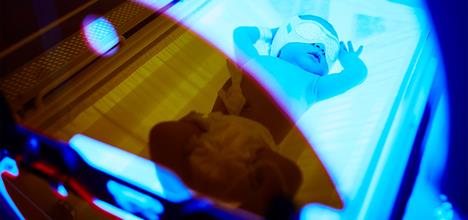Disclaimer [ENGLISH]
Disclaimer : This material is for educational purposes only. You, the reader, as...
What is jaundice?
- Jaundice is the yellow color that can be seen in the skin and eyes of many newborns.
- The yellow skin and eyes are an external sign that the amount of bilirubin in your child’s blood is too high.
- If the bilirubin gets very high, it can lead to serious brain damage and even death. Because of this, your child’s primary care provider will keep a close watch on this level.
What causes jaundice?
- It happens when a chemical called bilirubin builds up in the baby’s blood.
- Bilirubin comes from the breakdown of red blood cells and is removed by the liver.
- Before birth, the mother’s liver does this job for the baby.
- Your baby’s primary care provider will help determine why your baby has jaundice.
Physiologic/normal jaundice
- Many babies develop jaundice in the first few days of life because it can take a few days for the liver to get better at removing bilirubin.
- Up to half of all newborns have this type of jaundice.
- It usually starts on days 2-3, is the worst on days 4-5, and goes away around 1-2 weeks of age.
BreastFEEDING jaundice
- 5-10% of newborns have this type of jaundice.
- This is generally because of not eating enough breastmilk. These babies can have poor weight gain.
- It usually starts on days 2-3, is the worst on days 4-5, and goes away around 1-2 weeks of age.
- It usually resolves once the mother’s breastmilk supply has improved and the baby is feeding better.
BreastMILK jaundice
- 10 % of newborns have this type of juandice.
- It is due to a substance in the breastmilk which blocks the removal of bilirubin.
- It usually starts at 4-7 days of age and can last for 3-12 weeks.
- This type of jaundice is not harmful.
Other causes of jaundice
- Some jaundice can be caused by mother andbaby having different blood groups. This usually begins in the first 24 hours of life. It can reachharmful levels.
- Severe illness
- Other less common causes.
What are the symptoms of jaundice?
- Yellowing of the skin and eyes. It generally starts on the face and moves down the body. When it goes away, it goes in the opposite direction. It is common for the face and eyes to look yellow the longest.
- It is best seen when your baby is without clothes and in natural light, like near a window.
How is jaundice diagnosed?
At home
- You can check your baby by pressing on their skin with a finger – this removes their normal skin color. Check to see if the skin looks yellow where you pressed, before the normal skin color returns.
- Please contact your primary care provider if you think your baby is looking more yellow, or looks yellow on their stomach or legs.
In the office
- At CPCMG, we regularly check your newborn’s bilirubin (or jaundice level).
- Many times this will be done with a machine in the office that check’s your baby’s skin.
- If this result is high, your baby’s primary care provider may send you to the lab to get your baby’s blood drawn to get a more accurate result.
- Your baby’s primary care provider might send you to get your baby’s blood drawn for other reasons.
- If your baby’s primary care provider asks you to get your baby’s blood drawn at the lab, it is very important that you get this done in the timeframe they ask you to, and that you are available to answer your telephone to discuss the results.
How can I prevent jaundice?
Feed your baby frequently.
- Many breastfed newborn babies will feed ever one-and-a-half to 2 hours, while formula fed babies will feed every 2-3 hours.
- At this age, your baby should not go more than 3-4hours between feeds – even at night.
- If you would like to breastfeed your baby and are having difficulty with breastfeeding please ask for a referral to a CPCMG lactation consultant.
Monitor your baby’s urination and bowel movements.
- Bilirubin leaves the body through the bowel movements.
- If you see orange or red crystals in your baby’s urine, this is a sign that they are not feeding enough.
How is this treated?
If mild, your baby’s jaundice might be monitored in the office.
You and your child’s primary care provider will come up with a feeding plan that should help bring your baby’s weight up and their jaundice level down. You might have more frequent follow-up visits in the office.
If more severe, your baby might need to be be admitted to the hospital.

- Your baby’s jaundice will be treated with phototherapy – they will be placed them in an incubator under lights. This helps the bilirubin level go down.
- Their feeds will be maximized. Some hospitals will even have lactation consultants available to assist you with breastfeeding.
- Text BoxUnless your baby is admitted to the Intensive Care Unit, you will usually be able to stay in the hospital room with your baby.
When to call your healthcare team:
- Your baby looks more yellow – especially on the stomach or legs.
- Your baby is not feeding well, has a poor suck, or is too sleepy to feed.
- Your baby is having a decreased number of wet diapers, or you see orange or red crystals in their urine.
- Your baby has a fever.
- Your child is getting worse
- You have other questions or concerns.
This publication was adapted from information from American Academy of Pediatrics Patient Education Materials.
Reviewed by: FC D.O., CPCMG Newborn Committee, AR D.O. | 05/2024


